
Definition of Primary Active Transport
Primary active transport is a biological process in which cells move ions or molecules across a membrane against their concentration gradient, utilizing energy directly from the hydrolysis of adenosine triphosphate (ATP). This process is essential for maintaining cellular homeostasis and creating electrochemical gradients across membranes. The primary active transport mechanism involves specific transport proteins known as pumps, which are embedded in the cell membrane.
Mechanism of Primary Active Transport
- Energy Source: The process begins with the hydrolysis of ATP, which releases energy.
- Transport Protein Activation: This energy activates a specific transport protein (pump) that binds to the substrate (ion or molecule) on one side of the membrane.
- Conformational Change: The binding induces a conformational change in the protein, allowing it to translocate the substrate across the membrane.
- Release and Reset: Once on the opposite side, the substrate is released, and the pump returns to its original conformation to repeat the cycle.
Examples of Primary Active Transport
- Sodium-Potassium Pump (Na+/K+ ATPase): This pump actively transports sodium ions out of cells and potassium ions into cells against their concentration gradients. For every three sodium ions expelled, two potassium ions are imported, crucial for maintaining cellular potential and volume.
- Calcium Pump (Ca2+ ATPase): This pump moves calcium ions out of cells or into the sarcoplasmic reticulum in muscle cells, helping regulate intracellular calcium levels essential for muscle contraction and various signaling pathways.
- Proton Pump (H+ ATPase): Found in various cell types including parietal cells in gastric glands, this pump moves protons (H+) out of cells, contributing to acid secretion in the stomach and regulating pH levels.
- Hydrogen-Potassium Pump (H+/K+ ATPase): This pump exchanges hydrogen ions for potassium ions across epithelial cell membranes in gastric mucosa, playing a critical role in gastric acid secretion.
Secondary Active Transport—Co-Transport and Counter-Transport
Secondary active transport, also known as coupled transport, does not directly use ATP but relies on the electrochemical gradient established by primary active transport processes. It can be divided into two main types:
(a) Co-Transport (Symport)
In co-transport or symport mechanisms, two substances are transported simultaneously in the same direction across a membrane:
- Mechanism: The movement of one substance down its concentration gradient provides energy for another substance to move against its gradient.
- Example: The sodium-glucose transporter utilizes sodium’s inward gradient created by Na+/K+ ATPase to drive glucose uptake into intestinal epithelial cells against its concentration gradient.
(b) Counter-Transport (Antiport)
In counter-transport or antiport mechanisms, two substances are transported in opposite directions:
- Mechanism: Similar to co-transport, one substance moves down its concentration gradient while driving another substance against its gradient.
- Example: The sodium-calcium exchanger uses sodium’s influx to expel calcium from cardiac muscle cells during relaxation phases after contraction.
Active Transport Through Cellular Sheets
Active transport through cellular sheets refers to how epithelial tissues utilize both primary and secondary active transport mechanisms to regulate absorption and secretion processes effectively:
- Epithelial Structure: Epithelial tissues consist of tightly packed cells forming sheets that line surfaces and cavities throughout the body.
- Transcellular Transport Pathway:
- Substances may enter through apical membranes via specific channels or carriers.
- Once inside, they can be actively transported across cytoplasm using primary active transporters like Na+/K+ ATPase.
- Finally, they exit through basolateral membranes into interstitial fluid or blood vessels via secondary active transporters or facilitated diffusion.
- Examples in Physiology:
- In renal tubules, sodium reabsorption occurs primarily through Na+/K+ ATPase at basolateral membranes while glucose is reabsorbed via co-transport with sodium at apical membranes.
- In intestinal epithelium, nutrients such as amino acids and sugars are absorbed efficiently due to these coordinated active transport mechanisms.
The integration of these processes ensures that essential nutrients are absorbed while waste products are excreted efficiently from bodily systems.







